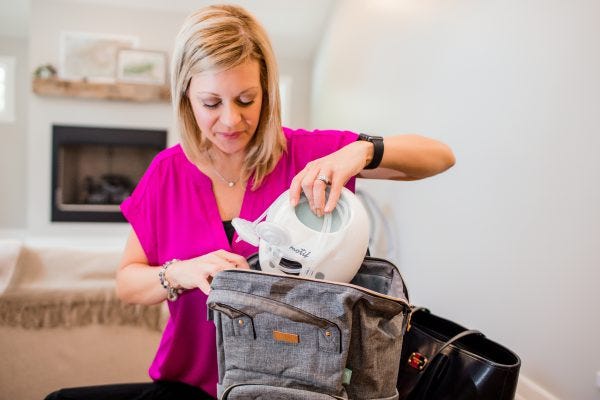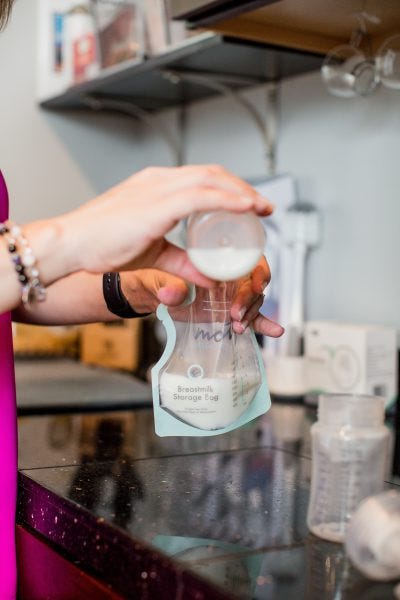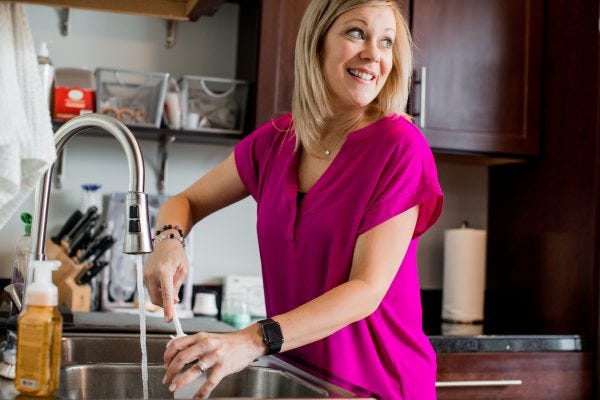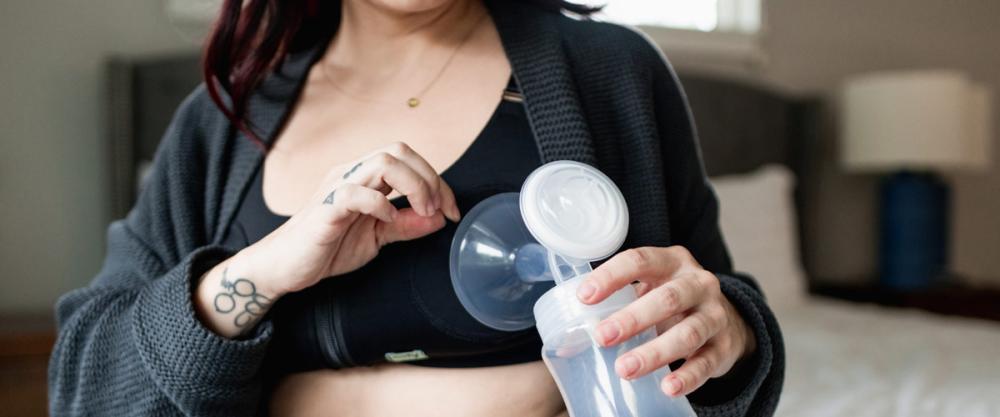Note: Kristy's breast pumping story is part of a #ThisisPumping photo series chronicling moms nursing as they transition back to work and daily life.
Age: 39
Occupation: Clinical Psychologist working with veterans with severe mental illness at the VA Medical Center and private practice at the Institute of Applied Neuroscience.
Second-Time Mom
Baby’s Name: Ella
Biggest challenge with breastfeeding or breast pumping so far?
“Time management and balancing work and family obligations.”
Biggest reward with breastfeeding or breast pumping so far?
“Bonding with baby!”
Where have you felt most supported breastfeeding or breast pumping?
“My family knows how important breastfeeding/pumping is to me. Although my mother and mother-in-law did not breastfeed, when I brought home the baby, they knew that teaching her how to feed was my number one priority. They knew to give us space during this time for which I’m very grateful (because it is NOT easy).”
Where have you felt most shamed breastfeeding or breast pumping?
"When in public, I feel that I need to hide and be very discreet when feeding my baby. I am hopeful that when I return to work I will have the privacy to pump a couple times a day without feeling shamed.”
Kristy, like most nursing moms, has anxiety in public when feeding depending on where she is and who she's with. She attributes it to constantly having to read the environment you’re in, not only logistically (will my stroller fit here, is there a place to sit and feed, etc.), but also socially.
A trip to church with the baby looks different than when she’s just walking around the neighborhood nursing Ella.
“Sometimes it’s more my issue than others. I just get in my head thinking about it. Breast pumping lets you navigate these issues with a little more freedom than without.”
Kristy starts every morning pumping by her bedside. Her day usually starts around 6am. She spends 10-15 minutes pumping and gets around 9-10 ounces during this time.
She gets the most milk in the morning hours and generally sets her Luna pump between Levels 5 and 8 for the best results.
Immediately after she pumps she pours the milk into bags and freezes or stores in the fridge.
Baby Ella is only 15 days old, so she’s building her supply of pumped milk for when she returns to work in 9 weeks.
Kristy nurses every 1.5 - 3 hours right now.
When Ella is sleeping, Kristy attempts to keep the household running by cooking and cleaning. At the end of the day, the family relaxes on the porch adjusting to their new norm with the baby.

Kristy describes the anxiety that comes with getting into a good daycare. After telling your husband you’re pregnant, she says the next person you need to tell is your future daycare. Luckily, her daughter was grandfathered in to a local church-based daycare because her older son attends school there.

This is Kristy’s second time breastfeeding. Before her firstborn though, she didn’t know much about breastfeeding or pumps. Because her mom didn’t breastfeed, she didn’t have a built-in support system. She found support through her friends.

The last time she breastfed and pumped was thirteen years ago. With her first child, he had issues with latching and tongue-tie. Doctors initially told her that her son would need surgery for the tongue-tie.
However, she visited a lactation specialist at the local health department who showed her helpful ways to sidestep this without surgery.
She also found support there when it came to a breast pump. Because a range of pumps weren’t covered by the Affordable Care Act at that time, she first had a manual pump through her insurance. The hand pump was time-consuming and stressful, and the stress caused by it let to problems with letdown.
Thankfully, the IBCLC at the health department told her she needed an electric pump, so she rented a large unit from them.
Kristy is impressed by how many more helpful gadgets are on pumps now compared to then, like the nightlight on her Luna. She loves that everyone is trying out a range of pumps now and rating the best ones so moms can make the best decision.
The greatest invention for her is having a hands-free pump bra. Now, when she pumps, she can get caught up on work, shop online and use social media.
She also found support there when it came to a breast pump. Because a range of pumps weren’t covered by insurance at that time, the first pump she had was a manual pump. The hand pump was time-consuming and stressful, and the stress caused by it led to problems with letdown.
Thankfully, the IBCLC at the health department told her she needed an electric pump, so she rented a large unit from them.

Kristy is impressed by how many more helpful gadgets are on pumps now compared to then, like the nightlight on her Luna. She loves that everyone is trying out a range of pumps now and rating the best ones so moms can make the best decision.
The greatest invention for her is having a hands-free pump bra. Now, when she pumps, she can get caught up on work, shop online and use social media.

When she had Ella, she had to have a conversation with her in-laws, who also hadn’t been previously exposed to breastfeeding. Initially, it can be awkward to have these conversations with relatives. Her in-laws stayed with her and her family the first two weeks after Ella was born. She made sure they knew that her number one priority was making sure she was fed.
She says, when you’re teaching your child how to feed, you don’t want to be sequestered to your bedroom in your own home. So, she made sure to have the conversation as soon as possible.
Kristy works at a private practice and the VA Hospital. When she returns to work at the hospital, she has a thirty minute lunch and two fifteen minute breaks throughout the day.
She spends both of those breaks pumping.
She thinks it’s a positive change that more and more women are breastfeeding and hopes workplaces can give women more flexible schedules. Although she’s able to pump within fifteen minutes, some women might need more time than that.
Kristy also believes that all workplaces should offer a comfortable space to pump and not just a glorified closet somewhere. The process of pumping shouldn’t leave you ostracized from your colleagues.
Her husband Jay is incredibly supportive and loves feeding the baby, which gives her the freedom to work and leave when needed. She stocks up on milk so the couple can switch shifts with feeding and give her more time to sleep. The day we visited Kristy was the first night she had slept longer than six hours in a month due to Jay’s help feeding.
Kristy's Story
Age: 39
Occupation: Clinical Psychologist working with veterans with severe mental illness at the VA Medical Center and private practice at the Institute of Applied Neuroscience.
Second-Time Mom
Baby’s Name: Ella
Biggest challenge with breastfeeding or breast pumping so far?
“Time management and balancing work and family obligations.”
Biggest reward with breastfeeding or breast pumping so far?
“Bonding with baby!”
Where have you felt most supported breastfeeding or breast pumping?
“My family knows how important breastfeeding/pumping is to me. Although my mother and mother-in-law did not breastfeed, when I brought home the baby, they knew that teaching her how to feed was my number one priority. They knew to give us space during this time for which I’m very grateful (because it is NOT easy).”
Where have you felt most shamed breastfeeding or breast pumping?
"When in public, I feel that I need to hide and be very discreet when feeding my baby. I am hopeful that when I return to work I will have the privacy to pump a couple times a day without feeling shamed.”
Kristy, like most nursing moms, has anxiety in public when feeding depending on where she is and who she's with. She attributes it to constantly having to read the environment you’re in, not only logistically (will my stroller fit here, is there a place to sit and feed, etc.), but also socially.
A trip to church with the baby looks different than when she’s just walking around the neighborhood nursing Ella.
“Sometimes it’s more my issue than others. I just get in my head thinking about it. Breast pumping lets you navigate these issues with a little more freedom than without.”
Kristy's Pumping Schedule
Kristy starts every morning pumping by her bedside. Her day usually starts around 6am. She spends 10-15 minutes pumping and gets around 9-10 ounces during this time.
She gets the most milk in the morning hours and generally sets her Luna pump between Levels 5 and 8 for the best results.
Immediately after she pumps she pours the milk into bags and freezes or stores in the fridge.
Baby Ella is only 15 days old, so she’s building her supply of pumped milk for when she returns to work in 9 weeks.
Kristy nurses every 1.5 - 3 hours right now.
When Ella is sleeping, Kristy attempts to keep the household running by cooking and cleaning. At the end of the day, the family relaxes on the porch adjusting to their new norm with the baby.
The Issue of Childcare

Kristy describes the anxiety that comes with getting into a good daycare. After telling your husband you’re pregnant, she says the next person you need to tell is your future daycare. Luckily, her daughter was grandfathered in to a local church-based daycare because her older son attends school there.
Breastfeeding in the Beginning

This is Kristy’s second time breastfeeding. Before her firstborn though, she didn’t know much about breastfeeding or pumps. Because her mom didn’t breastfeed, she didn’t have a built-in support system. She found support through her friends.
Breast Pumping Then and Now

The last time she breastfed and pumped was thirteen years ago. With her first child, he had issues with latching and tongue-tie. Doctors initially told her that her son would need surgery for the tongue-tie.
However, she visited a lactation specialist at the local health department who showed her helpful ways to sidestep this without surgery.
She also found support there when it came to a breast pump. Because a range of pumps weren’t covered by the Affordable Care Act at that time, she first had a manual pump through her insurance. The hand pump was time-consuming and stressful, and the stress caused by it let to problems with letdown.
Thankfully, the IBCLC at the health department told her she needed an electric pump, so she rented a large unit from them.
Kristy is impressed by how many more helpful gadgets are on pumps now compared to then, like the nightlight on her Luna. She loves that everyone is trying out a range of pumps now and rating the best ones so moms can make the best decision.
The greatest invention for her is having a hands-free pump bra. Now, when she pumps, she can get caught up on work, shop online and use social media.
She also found support there when it came to a breast pump. Because a range of pumps weren’t covered by insurance at that time, the first pump she had was a manual pump. The hand pump was time-consuming and stressful, and the stress caused by it led to problems with letdown.
Thankfully, the IBCLC at the health department told her she needed an electric pump, so she rented a large unit from them.

Kristy is impressed by how many more helpful gadgets are on pumps now compared to then, like the nightlight on her Luna. She loves that everyone is trying out a range of pumps now and rating the best ones so moms can make the best decision.
The greatest invention for her is having a hands-free pump bra. Now, when she pumps, she can get caught up on work, shop online and use social media.
Nursing Around Family

When she had Ella, she had to have a conversation with her in-laws, who also hadn’t been previously exposed to breastfeeding. Initially, it can be awkward to have these conversations with relatives. Her in-laws stayed with her and her family the first two weeks after Ella was born. She made sure they knew that her number one priority was making sure she was fed.
She says, when you’re teaching your child how to feed, you don’t want to be sequestered to your bedroom in your own home. So, she made sure to have the conversation as soon as possible.
Pumping at Work
Kristy works at a private practice and the VA Hospital. When she returns to work at the hospital, she has a thirty minute lunch and two fifteen minute breaks throughout the day.
She spends both of those breaks pumping.
She thinks it’s a positive change that more and more women are breastfeeding and hopes workplaces can give women more flexible schedules. Although she’s able to pump within fifteen minutes, some women might need more time than that.
Kristy also believes that all workplaces should offer a comfortable space to pump and not just a glorified closet somewhere. The process of pumping shouldn’t leave you ostracized from your colleagues.
Partner Support
Her husband Jay is incredibly supportive and loves feeding the baby, which gives her the freedom to work and leave when needed. She stocks up on milk so the couple can switch shifts with feeding and give her more time to sleep. The day we visited Kristy was the first night she had slept longer than six hours in a month due to Jay’s help feeding.







